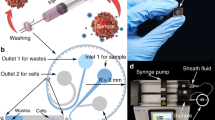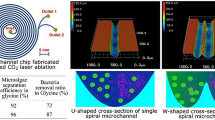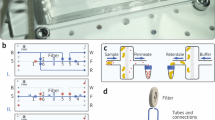Abstract
This study addresses the need to reduce the risk of clogging when preparing samples for cell concentration, i.e., the CaSki Cell-lines (epidermoid cervical carcinoma cells). Aiming to develop a non-clogging microconcentrator, we proposed a new counter-flow concentration unit characterized by the directions of penetrating flows being at an obtuse angle to the main flow, due to employment of streamlined turbine blade-like micropillars. Based on the optimization results of the counter-flow unit profile, a fractal arrangement for the counter-flow concentration unit was developed. A counter-flow microconcentrator chip was then designed and fabricated, with both the processing layer and collecting layer arranged in terms of the honeycomb structure. Visualized experiments using CaSki cell samples on the microconcentrator chip demonstrated that no cell-clogging phenomena occurred during the test and that no cells were found in the final filtrate. The test results show an excellent concentration performance for the microconcentrator chip, while a concentrating ratio of >4 with the flow rate being below 1.0 ml/min. As only geometrical structure is employed in the passive device, the counter-flow microconcentrator can be easily integrated into advanced microfluidic systems. Owing to the merit of non-clogging and continuous processing ability, the counter-flow microconcentrator is not only suitable for the sample preparation within biomedical field, but also applicable in water-particle separation.











Similar content being viewed by others
References
Arens K, Rentrop P, Stoll SO, Wever U (2005) An adjoint approach to optimal design of turbine blades. Appl Numer Math 53:93–105
Chen X, Cui D, Liu C et al (2007) Continuous flow microfluidic device for cell separation, cell lysis and DNA purification. Anal Chim Acta 584:237–243
Chen X, Cui DF, Liu CC, Li H (2008) Microfluidic chip for blood cell separation and collection based on crossflow filtration. Sens Actuators B Chem 130:216–221
Currie IG (1993) Fundamental mechanics of fluids. McGraw-Hill, Inc., New York, USA
Dong T, Yang Z (2008) Measurement and modeling of R141b condensation heat transfer in silicon rectangular microchannels. J Micromech Microeng 18:085012-1–085012-16
Dong T, Yang Z, Wu H (2006) Molecular simulations of R141b boiling flow in micro/nano channel: interfacial phenomena. Energ Convers Manage 47:2178–2191
Dong T, Yang Z, Bi Q, Zhang Y (2008) Freon R141b flow boiling in silicon microchannel heat sinks: experimental investigation. Heat Mass Transfer 44:315–324
Dong T, Yang Z, Egeland E et al (2009) Clogging failure in microfilter for blood cell separation and its novel improvements IEEE Proc 16th IPFA, 6–10 July, Suzhou, China, pp 759–763. doi:10.1109/IPFA.2009.5232727
Dong T, Su Q et al (2010) A smart fully integrated micromachined separator with soft magnetic micro-pillar arrays for cell isolation. J Micromech Microeng 20:115021-1–115021-9
Ikuta K, Maruo S, Fujisawa T et al (1999) Micro concentrator with opto-sense micro reactor for biochemical IC chip family. Proc of MEMS 99:376–381
Irimia D, Toner M (2006) Cell handling using microstructured membranes. Lab Chip 6:345–352
Ji X, Wang W, Lou X, et al. (2007) A centrifugation-enhanced high-efficiency micro-filter with spiral channel. TRANSDUCERS & EUROSENSORS ‘07, the 14th international conference on solid-state sensors, actuators and microsystems, Lyon, France, 10–14 June 2007
Kuiper S, van Rijn CJM, Nijdam W, Elwenspoek MC (1998) Development and applications of very high flux microfiltration membranes. J Memb Sci 150:1–8
Metz S, Trautmann C, Bertsch A, Ph Renaud (2004) Polyimide microfluidic devices with integrated nanoporous filtration areas manufactured by micromachining and ion track technology. J Micromech Microeng 14:324–331
Mielnik MM, Ekatpure RP, Sætran LR, Schönfeld F (2005) Sinusoidal crossflow microfiltration device—experimental and computational flowfield analysis. Lab Chip 5:897–903
Tran MN, Dong T, Su Q et al (2010) Design and optimization of non-clogging counter-flow microconcentrator for enriching epidermoid cervical carcinoma cells. Biomed Microdevices. doi:10.1007/s10544-010-9483-5
van Midwoud PM, Verpoorte E (2008) Implementing sample preconcentration in microfluidic devices. In: Landers JP (ed) Handbook of capillary and microchip electrophoresis and associated microtechniques. CRC Press, Boca Raton, FL
Yamada M, Seki M (2005) Hydrodynamic filtration for on-chip particle concentration and classification utilizing microfluidics. Lab Chip 5:1233–1239
Zheng S, Liu J, Tai Y (2008) Streamline-based microfliudic devices for erythrocytes and leukocytes separation. J Microelectromech S 17:1029–1038
Acknowledgments
This study was mainly supported by the subcontract of Norwegian Government NFR Funds (Project No.187981 POCNAD), and by Skjema for søknad om FoU-stipend og kompetanseheving på Høgskolen i Vestfold. We are grateful to our colleague, Richard Nelson, for his assistance in proofreading our drafts. The authors appreciated the supports and discussion from Dr. Anja Gulliksen, Dr. Lars Soli, and Dr Hanne Skomedal in NorChip AS.
Author information
Authors and Affiliations
Corresponding authors
Rights and permissions
About this article
Cite this article
Dong, T., Yang, Z., Su, Q. et al. Integratable non-clogging microconcentrator based on counter-flow principle for continuous enrichment of CaSki cells sample. Microfluid Nanofluid 10, 855–865 (2011). https://doi.org/10.1007/s10404-010-0717-x
Received:
Accepted:
Published:
Issue Date:
DOI: https://doi.org/10.1007/s10404-010-0717-x




